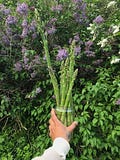Welcome back to building our ideal diets, week 3! Today we cover two components of a healthy diet that work to inform and support each other: fresh food and seasonal food. If these two components resonate with you, there is no better time to practice implementing them into your diet as locally grown foods become more widely available in the spring and summer months.
Fresh foods refer to the timing between harvesting and consumption and the proper storage of food.
We can often feel divorced from our food systems in an urban environment because of the conveniences of industrialization and globalization. We can buy strawberries at the corner store in February, and order any kind of food, from any country, at any hour through food delivery services on our phones. But when we pull the curtain back on the implications of these comforts, they reveal a short-sighted vision for both our bodies and the planet. Luckily, farmer’s market season is upon us, and supporting local growers is one of the easiest ways that we can provide our bodies with fresh foods. When I lived in the city I found that they helped strengthen my connection to food, nature, and my community. They also provide tons of inspiration! Fruits and vegetables look so much more appealing laid outdoors, in natural light, in piles of bounty compared to the harsh and clinical setting of a grocery store. You’ll also encounter food items that you may never have tried or heard of before! Here are all of my best tips for Farmers’ Market season so that you can experience the pleasure of shopping for fresh food.
When it comes to storage, produce is best eaten as fresh as possible, but these foods will store well for several weeks if done properly. Most fruit and vegetables keep well in the refrigerator, but it’s worth getting in the habit of washing and drying leafy greens and tender herbs and storing them in sealable bags in your crisper drawers. Items like potatoes, onions, garlic, and tomatoes, are best left at cool room temperatures. Nuts and seeds should be carefully stored in a closed container in a dark, cool, place or refrigerated - I do my seeds in the fridge since I use them most, and nuts in my pantry. Whole grains and legumes keep for years after harvesting, and I store them in mason jars in my pantry. Unless I have a plan for that night, or a couple of days from the time I purchase animal proteins, I throw them in the freezer as they can last several months. Just be sure to keep a list either on your fridge, or in your phone to keep track of inventory. Buying frozen organic produce is also a nice hack to consuming fresh foods as they are flash frozen pretty much directly after they are picked, so you won’t have to worry about storage and spoilage.
Eating with the seasons is a no-brainer when making an effort to consume fresh produce. If you’ve been subscribing to this newsletter for a while, you know this is a big part of my personal nutrition practice. Eating seasonally keeps us attuned to the earth, its elements, and the cycles of nature and time. It champions the intrinsic knowledge of Mother Earth, that our environment provides the best foods to support our health, keep us in balance, and protect us in our respective climates. Eating locally grown foods when they are available to us reattunes us to our own bodily cycles and provides an economical and sustainable solution to choosing what to eat as it implies eating locally. Talk about holistic!
Each season provides us with different challenges environmentally, energetically, spiritually, emotionally, mentally, and we can tune into and honour these changes through the food we choose to nourish with.
Spring is a time for purification, healing, and rejuvenation. We may consider doing a cleanse, or a fast, and we start to gravitate towards the young green foods that grow in nature, which support our bodies’ natural detoxification processes. Here are my guidelines for spring nutrition :)
Summer is a time for growth and activity, things are expanding, and our diets are lighter and fresher. We reach for more fresh fruits, raw vegetables and reduce the amount of cooked foods we eat as things heat up.
Autumn is harvest time when we experience a big shift in energy, climate, and diet. As the weather cools, and the days shorten, we start to consume warmer foods, whole grains, richer proteins and fats.
Winter has us craving richer, heat-building foods that require more preparation as we spend more time at home resting and recharging.
I have so much fun using the seasons as a guiding light to my nutritional plan. It takes so much guesswork out of what to eat or cook when I prioritize produce that is in season and grown nearby. It also sparks loads of creativity when you play the cards you’re dealt. This week I encourage you to seek out where your local farmers market will be and make a promise to yourself to visit at least once a season - spring, summer, fall - though I have a feeling you might make it there a few more times! If that’s not available to you, think about seasonal and local foods on your trip to the grocery store or fruit market, and try to prioritize foods grown in your province, state, or country. You could also try out a new recipe with seasonal foods like asparagus, leeks, rhubarb, dandelion greens, etc. If you need suggestions, you know where to find me!



